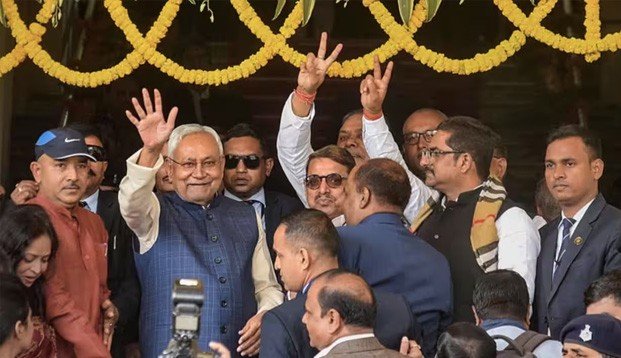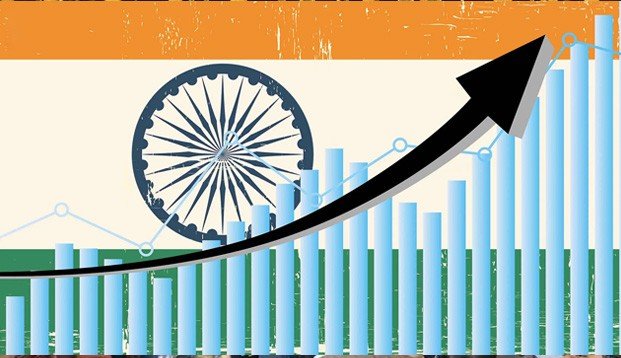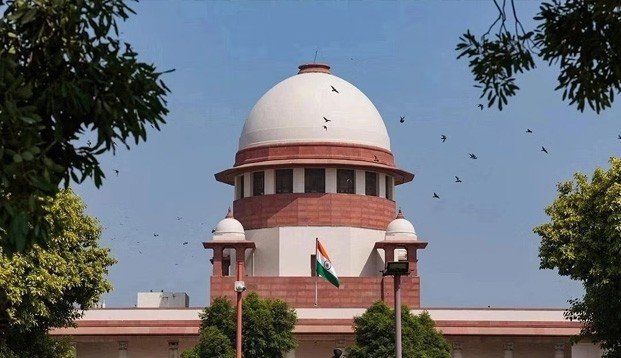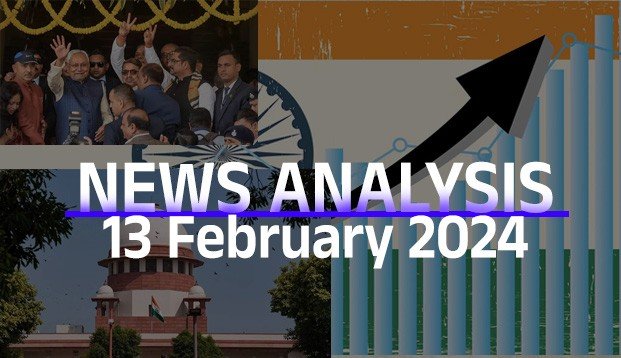13th February, 2024 (Tuesday)
| CONTENT LIST | ||
| Topics | Syllabus | |
| 1 | Floor Test / Confidence Motion / Trust Vote | GS.2: Indian Polity – State Legislature |
| 2 | India’s Retail Inflation Trends | GS.3: Indian Economy – Inflation |
| 3 | Post of Deputy Chief Ministers | GS.2: Indian Polity – State Executive |
| 4 | Swachhata Green Leaf Rating System (SGLR) | GS.2: Social Sector – Health & Tourism Sector |
| 5 | Alliance For Global Good Gender Equity & Equality | GS.2: IR: International Institutions & Alliance |
| 6 | India-Qatar Relations Advance as Indian Navy Veterans Released | GS.2: IR: India & West Asia |
| 7 | Index of Industrial Production (IIP) | GS.3: Indian Economy – Indices & Reports |
| 8 | Understanding Black Hole | GS.1 & GS.3: Geography & Space Science |
VOTE OF CONFIDENCE / TRUS VOTE / FLOOR TEST
GS.2: Indian Polity – State Legislature
Why it’s in the News: Nitish Kumar’s NDA government in Bihar clinched a victory in the Assembly’s trust vote with 129 MLAs backing the administration.

About Vote of Confidence / Trust Vote / Floor Test
- What is a floor test?
- A trust vote, floor test, or no-confidence motion is a constitutional mechanism to determine the legislature’s support for the governing administration.
- The trust vote maintains political accountability of the elected government to the state legislature, applicable in both the parliament and state legislative assemblies.
- While the Constitution doesn’t explicitly mention ‘No confidence motion’ or ‘floor test,’ Articles 75 and 164 emphasize the executive’s collective responsibility to their respective legislatures.
- In the case of states, a trust vote is exclusively conducted in the lower house or legislative assembly, known as the Vidhan Sabha.
- Procedure:
- According to the Constitution, the Governor of the state appoints the Chief Minister.
- When a single party secures a majority of seats, its leader is appointed as the Chief Minister by the Governor.
- If the majority is contested, the claiming party’s leader must move a vote of confidence to prove majority among those present and voting.
- Failure to prove majority results in the Chief Minister’s resignation.
- In cases of coalition government disputes, the Governor can request the Chief Minister to demonstrate majority support in the house.
- The majority is counted based on those present and voting.
- This can also be done through a voice vote where the member can respond orally or through division voting. Some legislators may be absent or choose not to vote.
- In division vote, voting can be done through electronic gadgets, ballots or slips.
- The person who has the majority will form the government.
- In case of tie, the speaker can also cast his vote.
- What is composite floor test?
- There is another test, Composite Floor Test, which is conducted only when more than one person stakes claim to form the government.
- When the majority is not clear, the governor might call for a special session to see who has the majority.
| News Plus Key Supreme Court rulings on trust votes and the Governor’s role:Shivraj Chouhan vs Speaker (2018):Governor can call for a trust vote if they believe the government lacks legislative confidence, without favoring any party.Trust vote can proceed even if cases against rebel MLAs are pending.Governor’s decision to call for a trust vote can be reviewed judicially.SR Bommai Case (1994):Chief Minister’s refusal to undergo a floor test indicates loss of legislative confidence.Nabam Rebia case (2016):Governor’s actions like summoning or dissolving the House require advice from the council of ministers.Governor can order a floor test if they believe the Chief Minister and council of ministers lack legislative support.Pratap Gowda Patil vs State of Karnataka (2019):Rebel MLAs have the right to abstain from the floor test.Governor can dissolve the Assembly if the government lacks legislative support. |
INDIA’S RETAIL INFLATION TRENDS: INSIGHTS AND ANALYSIS
Syllabus: GS.3: Indian Economy – Inflation
Why it’s in the News: India’s retail inflation experienced a notable decline, dropping to a three-month low of 5.1% in January, down from 5.7% in the previous month. This moderation is primarily attributed to a slight cooling in food prices, which saw an increase of 8.3% compared to 9.5% in December 2023.

While January’s headline inflation pace remains slightly higher than the 5% average projected by the Reserve Bank of India (RBI) for the final quarter of 2023-24, it indicates a positive trajectory towards stabilizing consumer prices.
Understanding Retail Inflation:
- Retail inflation, or Consumer Price Index (CPI) inflation, tracks the rate at which prices of goods and services commonly purchased by consumers rise over time.
- Categories Covered by CPI
- CPI encompasses various categories such as food, clothing, housing, transportation, and medical care, providing a comprehensive snapshot of consumer spending patterns.
- Types of CPI
- There are four main types of CPI: CPI for Industrial Workers (IW), Agricultural Labourer (AL), Rural Labourer (RL), and Urban Non-Manual Employees (UNME).
- The first three CPI categories are compiled by the Labour Bureau under the Ministry of Labour and Employment, while the fourth is compiled by the National Statistical Office (NSO) under the Ministry of Statistics and Programme Implementation.
- Base Year and Updates
- The base year for CPI is 2012, with periodic updates reflecting changing consumption patterns.
- For instance, in 2020, the Ministry of Labour and Employment introduced a new series of CPI for Industrial Worker (CPI-IW) with a base year of 2016.
- Significance for Monetary Policy
- CPI data plays a crucial role in monetary policy decisions.
- The Monetary Policy Committee (MPC) utilizes CPI data to assess inflation trends and implement measures to manage inflation.
- Since April 2014, the RBI has adopted CPI as its primary measure of inflation, underscoring its importance in economic policy-making.
- Inflation at Wholesale Level
- In India, the Wholesale Price Index (WPI) stands as the predominant method for calculating inflation at the wholesale level.
- This index is released by the Office of Economic Advisor under the Ministry of Commerce and Industry.
- WPI Calculation:
- The WPI aggregates the prices of a comprehensive basket of 676 items.
- While it provides a broad view of price movements in goods, it notably excludes services from its calculations.
- Moreover, it fails to capture the intricacies and bottlenecks within the supply chain, neglecting the dynamics between producers, wholesalers, and retailers.
- Transition to CPI:
- Historically, the Reserve Bank of India (RBI) relied on WPI for formulating its monetary policy decisions.
- However, the index’s limitations became apparent over time. Recognizing the need for a more comprehensive inflation gauge, RBI Governor Raghu Ram Rajan spearheaded reforms in 2014.
- As part of this initiative, RBI shifted its focus from WPI to the Consumer Price Index (CPI) for policy decisions, aiming for a more accurate reflection of inflation dynamics encompassing both goods and services.
| NEWS PLUS Headline InflationHeadline Inflation is the measure of total inflation within an economy. It includes price rise in food, fuel and all other commodities.The inflation rate expressed in Wholesale Price Index (WPI) usually denotes the headline inflation. Though Consumer Price Index (CPI) values are often higher, WPI values traditionally make headlines.Core Inflation (Underline Inflation or Non-food Inflation)Core inflation is also a term used to denote the extend of inflation in an economy. But Core inflation does not consider the inflation in food and fuel. This is a concept derived from headline inflation.There is no index for direct measurement of core inflation and now it is measured by excluding food and fuel items from Wholesale Price Index (WPI) or Consumer Price Index (CPI).Core inflation = Headline inflation – (Food and Fuel) inflation. |
THE POST OF DEPUTY CM
Syllabus: GS.2: Indian Polity – State Executive
Why it’s in the News: Supreme Court dismisses petition challenging Deputy Chief Ministers’ appointments, stating they are state MLAs and ministers, finding no constitutional breach.

About the post of Deputy CM:
- Evolution and Significance
- The appointment of Deputy Chief Ministers (Deputy CMs) in Indian politics signifies a pragmatic political compromise often seen in coalition governments or in scenarios lacking a single dominant leader within the ruling party.
- Contemporary Presence
- Deputy CMs have become increasingly prevalent, with notable representation in states such as Madhya Pradesh, Rajasthan, Telangana, and Chhattisgarh.
- This trend underscores their growing importance in state-level governance structures.
- Beyond Bihar, numerous states across India boast Deputy CMs, with diverse configurations seen in different states, including coalition governments and single-party rule.
- Understanding the Role
- While not explicitly outlined in the Constitution, Deputy CMs are considered equivalent to Cabinet Ministers and play a pivotal role in aiding and advising the Governor, as per Article 163(1) of the Constitution.
- Historical Context
- The concept of Deputy CMs dates back to post-independence India, with figures like Anugrah Narayan Sinha in Bihar being among the earliest holders of this position.
- Their prevalence increased following the decline of the Congress party’s dominance after 1967, with significant examples from states like Bihar, Uttar Pradesh, Madhya Pradesh, and Haryana.
- National Significance
- India has also witnessed the appointment of Deputy Prime Ministers, reflecting the complexities of national coalition politics.
- Figures like Sardar Vallabhbhai Patel, Morarji Desai, and Lal Krishna Advani have held this position, with debates arising over their constitutional roles.
- Legal Clarifications
- Court rulings, such as the case of Devi Lal’s appointment as Deputy PM, have clarified that the title does not confer additional powers beyond those of a regular Minister, emphasizing adherence to constitutional norms.
In essence, the role of Deputy CMs and Deputy Prime Ministers in Indian politics exemplifies the adaptability of democratic governance to accommodate diverse interests while upholding constitutional principles.
SWACHHATA GREEN LEAF RATING SYSTEM (SGLR)
Syllabus: GS.2: Social Sector – Health & Tourism Sector
Why it’s in the News: A government-led rating system, Swachhata Green Leaf Rating, for hospitality sector hygiene faces low uptake, with only a pilot in Jammu and Kashmir. Despite ministry efforts, no state has adopted it, highlighting challenges in promoting safe sanitation practices in lodging facilities.
About Swachhata Green Leaf Rating System (SGLR)
- The Swachhata Green Leaf Rating System (SGLR), launched by the Department of Drinking Water and Sanitation (DDWS) in collaboration with the Ministry of Tourism on 2nd November, 2023.
- It is a pivotal initiative aimed at enhancing sanitation practices in India’s hospitality sector.
- This system, rolled out during the State Tourism Secretaries Meeting in late November 2023, is designed to rate hospitality facilities across the country based on their compliance with sanitation standards.
- Pioneering Implementation in Jammu and Kashmir:
- The SGLR was initially piloted in the Union Territory of Jammu and Kashmir, showcasing its potential as a model for other tourist destinations.
- A joint policy document crafted by DDWS and the Ministry of Tourism serves as a guiding framework for the successful implementation of the rating system in this region.
- Significance of Sanitation in Tourism:
- Tourism plays a vital role in the economy, fostering social and cultural ties.
- The reputation of tourist destinations is significantly influenced by factors such as aesthetic appeal and sanitation standards.
- Maintaining high levels of cleanliness requires coordinated efforts and planning.
- Objectives and Expectations of SGLR:
- Under the SGLR, safe sanitation practices are expected to enhance awareness and collaboration towards common goals in the tourism and hospitality sectors.
- This includes ensuring adequate sanitation facilities for all, waste segregation, maintaining litter-free environments, and implementing sustainable management practices for greywater.
- Furthermore, the promotion of alternatives to single-use plastics is a key objective of the system.
- Voluntary Participation and Phased Approach:
- Participation in the SGLR is voluntary for hospitality facilities, encompassing various types of tourist accommodations.
- Operators are encouraged to develop infrastructure, adopt best practices, and contribute to sanitation awareness as part of responsible tourism.
- The rating system consists of three phases: Orientation, Voluntary Declaration, and Verification, with monitoring and oversight conducted by state and district committees, alongside a verification sub-committee.
- Challenges faced by the SGLR:
- Resistance to Adoption: States exhibit reluctance in embracing the SGLR, indicating entrenched challenges in implementing standardized hygiene protocols.
- Implementation Hurdles: Scaling the SGLR nationwide is hindered by regional factors, bureaucratic obstacles, and differing stakeholder priorities.
- Fragmented Collaboration: Despite aims to enhance sanitation awareness and collaboration, achieving widespread buy-in remains challenging, requiring sustained advocacy efforts.
- Operational Complexity: Voluntary participation and multi-phased approaches introduce operational challenges, necessitating substantial investment in infrastructure and staff training.
- Sustainability Dilemmas: Balancing environmental concerns with economic viability poses dilemmas, especially regarding eco-friendly alternatives and waste management strategies.
- Conclusion:
- The Swachhata Green Leaf Rating System represents a significant step towards promoting safe sanitation practices in India’s hospitality sector.
- Addressing the challenges requires a comprehensive strategy, including collaborative efforts, regulatory support, and targeted interventions to ensure the SGLR’s success in promoting safe sanitation practices in India’s hospitality sector.
ALLIANCE FOR GLOBAL GOOD- GENDER EQUITY AND EQUALITY
Syllabus: GS.2: IR: International Institutions & Alliance
Why it’s in the News: India’s establishment of the “Global Alliance for Global Good – Gender Equity and Equality” at the 54th annual World Economic Forum in Davos aligns with its commitment to equality and inclusion, bolstered by initiatives like the New Delhi Leaders’ Declaration. This alliance signifies India’s leadership in promoting women’s empowerment and gender equality on a global scale, gaining full support from the World Economic Forum.
Key Highlights of the Alliance
- The alliance stems from the G20 Summit 2023 Leaders’ Declaration, reflecting India’s dedication to women-led development.
- The primary goal is to consolidate global best practices, facilitate knowledge sharing, and drive investments in women’s health, education, and enterprise.
- It builds upon initiatives from the Engagement Group and frameworks like Business 20, Women 20, and G20 EMPOWER.
- Aligned with the G20 EMPOWER initiative, it aims to enhance women’s leadership and empowerment in the private sector.
- Backed by the Bill and Melinda Gates Foundation, the alliance will be hosted by the Confederation of Indian Industry (CII) Centre for Women Leadership. CII, a non-government, not-for-profit organization, fosters an environment conducive to India’s development.
- The alliance aims to amplify women-led development, aligning with India’s ethos of inclusive growth.
| NEWS PLUS: About World Economic Forum (WEF): Headquartered in Geneva, Switzerland, the WEF, founded by Klaus Schwab in 1971, aims to unite public and private sectors to address global challenges.Purpose and Essence:Convenes leaders from business, government, and civil society to address global challenges.Initially focused on European firms, the WEF has expanded to address a wide range of economic and social issues.Annual Meeting in Davos:Introduced a membership system in 1975 for the world’s top 1,000 companies.Davos serves as a platform for international diplomacy, hosting historic meetings and discussions.The idea for the G20 emerged from WEF discussions in 1998, initially focusing on global finance. Funding and Setting:Supported primarily by partnering corporations, often with turnovers exceeding $5 billion.Davos’s tranquil environment fosters a more prosperous global economy.Impact:Publishes influential reports such as the Global Competitiveness Report.The WEF Summit fosters cooperation and innovation on a grand scale.Conclusion: The WEF plays a pivotal role in driving global cooperation, bringing leaders together to address pressing challenges and foster positive change. |
INDIA-QATAR RELATIONS ADVANCE AS INDIAN NAVY VETERANS RELEASED
Syllabus: GS.2: IR: India & West Asia (Mains Perspective)
Why it’s in the News: India-Qatar relations have seen a recent development with the release of eight Indian Navy veterans who had been in Qatari custody since August 30, 2022. This event marked a significant moment in bilateral ties as Prime Minister Narendra Modi announced his visit to Qatar on his way back from the United Arab Emirates.
India-Qatar Relations Take Stride Forward with Release of Indian Navy Veterans
- The release of the prisoners was facilitated by diplomatic efforts, with Foreign Secretary Vinay Mohan Kwatra expressing gratitude for the decision of Qatari legal authorities.
- The details surrounding the case leading to the arrest of the individuals remained sensitive and were not disclosed to the media.
- Despite the diplomatic tensions arising from the case, economic ties between India and Qatar have remained intact, exemplified by the signing of a $78 billion liquified natural gas (LNG) deal extending till 2048.
- Qatar’s role as a major supplier of energy to India and the significant presence of Indian workers in Qatar underscore the importance of the bilateral relationship.
- Furthermore, the release of the Indian Navy veterans ahead of Prime Minister Modi’s visit to Qatar highlights the diplomatic efforts undertaken to resolve the issue.
- This development is indicative of the multifaceted relationship between India and Qatar, encompassing political ties, trade, investment, energy partnerships, as well as cultural and security cooperation.
INDEX OF INDUSTRIAL PRODUCTION (IIP)
Syllabus: GS.3: Indian Economy – Indices & Reports
Why it’s in the News: In December 2023, India’s Index of Industrial Production (IIP) rose to 3.8%, a recovery from November’s 2.4%, driven by manufacturing growth.
About the Index of Industrial Production (IIP)
- The Index of Industrial Production (IIP) stands as a pivotal gauge of economic progress, offering insights into the trajectory of industrial output over time relative to a chosen base year.
- This metric serves as a vital indicator, revealing the fluctuations and shifts in physical production across various industries during a specified period.
- Key Highlights:
- Prime Indicator:
- The IIP is a cornerstone indicator used to measure trends in industrial production, offering crucial insights into economic growth and development.
- Monthly Publication:
- Compiled and disseminated by the National Statistical Office (NSO) on a monthly basis, the IIP provides timely updates on industrial performance.
- Base Year Significance:
- With the base year assigned a value of 100, the IIP reflects changes in industrial output relative to this benchmark.
- The current base year for the IIP series in India is 2011-12.
- Prime Indicator:
- Interpreting Growth:
- A reading of, for instance, 116 indicates a 16% growth compared to the base year, providing a clear measure of production expansion or contraction.
- Understanding the nuances of the IIP offers policymakers, economists, and businesses valuable insights into the health and trajectory of industrial sectors, aiding in informed decision-making and strategic planning.
UNDERSTANDING BLACK HOLES
Syllabus: GS.3: Indian Economy: IMF’s Report in News
Why it’s in the News: The Event Horizon Telescope (EHT), a global network of radio telescopes, revealed the first image of a black hole in 2019, confirming Einstein’s theory. Recent data depicts detailed features, confirming predictions and showcasing shifts in the black hole’s surroundings.
About Black Holes
- Defining Black Holes
- Black holes are regions of space with immense gravity where even light cannot escape.
- They form from the collapse of massive stars, far exceeding the mass of our sun.
- The collapse compresses all remaining material into an infinitesimally small point.
- The Essence of EHT
- Black holes, predicted by Einstein’s theory of relativity, appear as dark regions amidst luminous surroundings like glowing gas discs.
- The Event Horizon Telescope (EHT) aims to capture these shadows, revealing the presence of black holes.
- The EHT comprises a network of eight ground-based radio telescopes worldwide.
- Additional observatories have joined over time, including ALMA in Chile, enhancing observational capabilities.
- This collective array provides unprecedented insights into black hole phenomena.
- Very-long-baseline interferometry (VLBI) links radio telescopes worldwide, creating a virtual Earth-sized telescope.
- VLBI enables the EHT to achieve an angular resolution of 20 micro-arcseconds, crucial for detailed measurements.
- Black holes entered physics through Einstein’s theories over a century ago.
- Recent milestones, like LIGO’s detection of gravitational waves, have advanced our understanding.
- Visual confirmation of black holes, as achieved by the EHT, represents a pivotal milestone in scientific exploration, shedding light on fundamental processes shaping galaxies.


